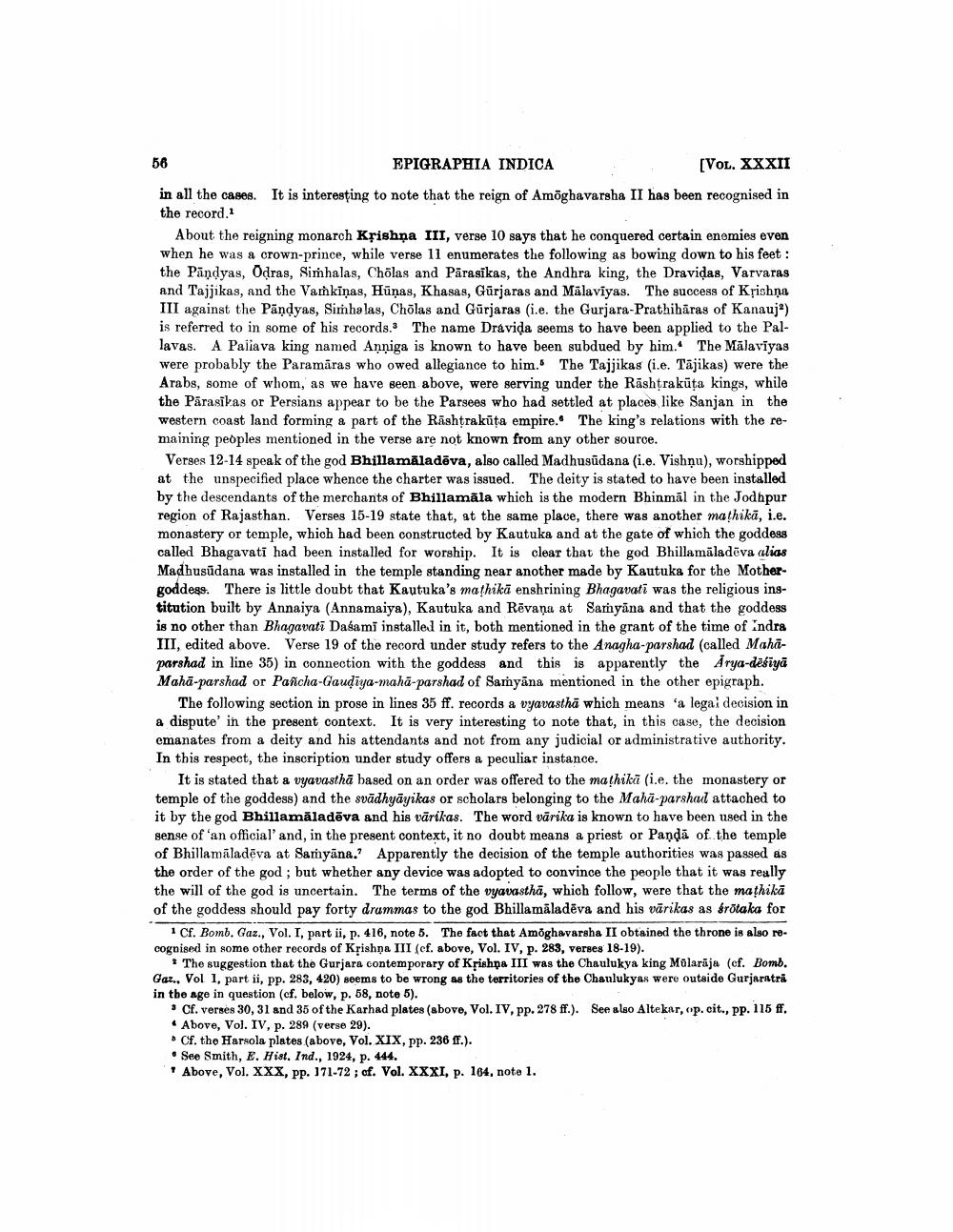________________
56
EPIGRAPHIA INDICA
[VOL. XXXII
in all the cases. It is interesting to note that the reign of Amoghavarsha II has been recognised in the record.1
About the reigning monarch Krishna III, verse 10 says that he conquered certain enemies even when he was a crown-prince, while verse 11 enumerates the following as bowing down to his feet: the Pandyas, Odras, Simhalas, Chōlas and Parasīkas, the Andhra king, the Dravidas, Varvaras and Tajjikas, and the Vamkīņas, Hūnas, Khasas, Gurjaras and Malaviyas. The success of Krishna III against the Pandyas, Simhalas, Chōlas and Gurjaras (i.e. the Gurjara-Prathihāras of Kanauj3) is referred to in some of his records. The name Dravida seems to have been applied to the Pallavas. A Paliava king named Anniga is known to have been subdued by him. The Malaviyas were probably the Paramaras who owed allegiance to him. The Tajjikas (i.e. Tājikas) were the Arabs, some of whom, as we have seen above, were serving under the Rashtrakuta kings, while the Parasīkas or Persians appear to be the Parsees who had settled at places like Sanjan in the western coast land forming a part of the Rashtrakuṭa empire. The king's relations with the remaining peoples mentioned in the verse are not known from any other source.
Verses 12-14 speak of the god Bhillamāladēva, also called Madhusudana (i.e. Vishnu), worshipped at the unspecified place whence the charter was issued. The deity is stated to have been installed by the descendants of the merchants of Bhillamala which is the modern Bhinmal in the Jodhpur region of Rajasthan. Verses 15-19 state that, at the same place, there was another maṭhikā, i.e. monastery or temple, which had been constructed by Kautuka and at the gate of which the goddess called Bhagavati had been installed for worship. It is clear that the god Bhillamaladeva alias Madhusudana was installed in the temple standing near another made by Kautuka for the Mothergoddess. There is little doubt that Kautuka's mathika enshrining Bhagavati was the religious institution built by Annaiya (Annamaiya), Kautuka and Rēvana at Samyana and that the goddess is no other than Bhagavati Dasami installed in it, both mentioned in the grant of the time of Indra III, edited above. Verse 19 of the record under study refers to the Anagha-parshad (called Mahaparshad in line 35) in connection with the goddess and this is apparently the Arya-desiyā Maha-parshad or Pancha-Gaudiya-maha-parshad of Samyana mentioned in the other epigraph.
The following section in prose in lines 35 ff. records a vyavastha which means 'a legal decision in a dispute' in the present context. It is very interesting to note that, in this case, the decision emanates from a deity and his attendants and not from any judicial or administrative authority. In this respect, the inscription under study offers a peculiar instance.
It is stated that a vyavastha based on an order was offered to the mathika (i.e. the monastery or temple of the goddess) and the svadhyāyikas or scholars belonging to the Maha-parshad attached to it by the god Bhillamāladēva and his värikas. The word varika is known to have been used in the sense of 'an official' and, in the present context, it no doubt means a priest or Panda of the temple of Bhillamaladeva at Samyana. Apparently the decision of the temple authorities was passed as the order of the god; but whether any device was adopted to convince the people that it was really the will of the god is uncertain. The terms of the vyavastha, which follow, were that the mathikā of the goddess should pay forty drummas to the god Bhillamaladeva and his värikas as árōtaka for
1 Cf. Bomb. Gaz., Vol. I, part ii, p. 416, note 5. The fact that Amoghavarsha II obtained the throne is also recognised in some other records of Krishna III (cf. above, Vol. IV, p. 283, verses 18-19).
The suggestion that the Gurjara contemporary of Krishna III was the Chaulukya king Mularāja (cf. Bomb. Gaz., Vol 1, part ii, pp. 283, 420) seems to be wrong as the territories of the Chaulukyas were outside Gurjaratrā in the age in question (cf. below, p. 58, note 5).
* Cf. verses 30, 31 and 35 of the Karhad plates (above, Vol. IV, pp. 278 ff.). See also Altekar, op. cit., pp. 115 ff. Above, Vol. IV, p. 289 (verse 29).
Cf. the Harsola plates (above, Vol. XIX, pp. 236 ff.).
See Smith, E. Hist. Ind., 1924, p. 444.
Above, Vol. XXX, pp. 171-72; cf. Vol. XXXI, p. 164, note 1.




